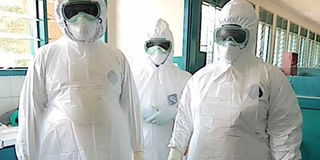Panic as health ministry confirms Crimean Congo fever in Kagadi

Health workers at Kagadi general hospital wear protective gear before attending to a patient who tested positive for Crimean-Congo haemorrhagic fever. COURTESY PHOTO
What you need to know:
- The health ministry intends to embark on sensitizing Ugandans especially the residents of Kagadi District about the spread of epidemic diseases such as Ebola and Crimean-Congo haemorrhagic Fever.
- The Senior Public Relations Officer at the Ministry of Health Mr Emmanuel Ainebyoona asked the people in Kagadi to remain calm because the district health team is able to handle and contain the disease.
Medical officials have confirmed the outbreak of Crimean-Congo haemorrhagic fever (CCHF) in Kagadi District in western Uganda after a 23 -year-old man tested positive for the highly contagious viral tick-borne disease.
The patient who is a resident of Kisuura village, Bwikara Sub County in Kagadi District was admitted to Kagadi hospital on Monday.
Mr Kefa Madira, the case management head in the district said the patient was complaining of fever, headache, abdominal pain, general body weakness and vomiting blood. Samples were obtained from him and sent it to the Uganda Virus research institute.
The presence of the patient caused a scare at Kagadi hospital on Tuesday as several patients fled from the wards.
Word went round at the hospital that the patient could have contracted Ebola, a similarly highly contagious disease. Several patients and their care givers were seen fleeing from the hospital until local leaders and medical officials intervened to calm them down.
Ms Robinah Nabanja, the state minister for health said results from the samples that were taken from the patient tested positive for Crimean-Congo haemorrhagic fever and negative for other viral haemorrhagic fevers like Ebola, Marburg and Rift Valley Fever. The patient has been put in an isolation ward at Kagadi General Hospital.
Ms Nabanja explained that the ministry intends to embark on sensitizing Ugandans especially the residents of Kagadi District about the spread of epidemic diseases such as Ebola and Crimean-Congo haemorrhagic Fever.
She said a National Rapid Response team from the Ministry of Health has been dispatched to back up medical officials in the district to handle the outbreak.
The Senior Public Relations Officer at the Ministry of Health Mr Emmanuel Ainebyoona asked the people in Kagadi to remain calm because the district health team is able to handle and contain the disease.
“Yes, one case of Crimean-Congo haemorrhagic Fever has been confirmed in Kagadi District but the members of the public should remain calm because the medical officials have the expertise to contain that disease. There is no Ebola in Kagadi or in any part of Uganda,” Mr Ainebyoona said.
In April 2019, the Ministry of health confirmed the outbreak of the Crimean-Congo Hemorrhagic Fever in Kikingura village in Bwijanga Sub-county in Masindi District. However, the disease was contained.
The deceased was a health worker who died at the end of December 2018. Medical officials obtained samples from the deceased and the blood sample tested positive of the Crimean Congo hemorrhagic fever.
The deceased was given a supervised burial by medical officers to ensure that mourners are not exposed to any possible infection. No relative was allowed to access the body.
Symptoms
According to the World Health Organisation, onset of symptoms is sudden, with fever, myalgia, (muscle ache), dizziness, neck pain and stiffness, backache, headache, sore eyes and photophobia (sensitivity to light). There may be nausea, vomiting, diarrhoea, abdominal pain and sore throat early on, followed by sharp mood swings and confusion. After two to four days, the agitation may be replaced by sleepiness, depression and lassitude, and the abdominal pain may localize to the upper right quadrant, with detectable hepatomegaly (liver enlargement).
Other clinical signs include tachycardia (fast heart rate), lymphadenopathy (enlarged lymph nodes), and a petechial rash (a rash caused by bleeding into the skin) on internal mucosal surfaces, such as in the mouth and throat, and on the skin.
The mortality rate from CCHF is approximately 30%, with death occurring in the second week of illness. In patients who recover, improvement generally begins on the ninth or tenth day after the onset of illness.
Fact box
Crimean-Congo haemorrhagic fever is a viral haemorrhagic fever transmitted by ticks. It can be responsible for severe outbreaks in humans but it is not pathogenic for ruminants, their amplifying host.
According to the World Health Organization, Crimean-Congo haemorrhagic fever (CCHF) spreads to humans either by tick-bites, or through contact with viraemic animal tissues during and immediately post-slaughter.
CCHF outbreaks constitute a threat to public health services because of its epidemic potential, its high case fatality ratio (10-40%), its potential for nosocomial outbreaks and the difficulties in treatment and prevention.
The disease was first described in the Crimea in 1944 and given the name Crimean haemorrhagic fever. In 1969 it was recognized that the pathogen causing Crimean haemorrhagic fever was the same as that responsible for an illness identified in 1956 in the Congo, and linkage of the two place names resulted in the current name for the disease and the virus.




